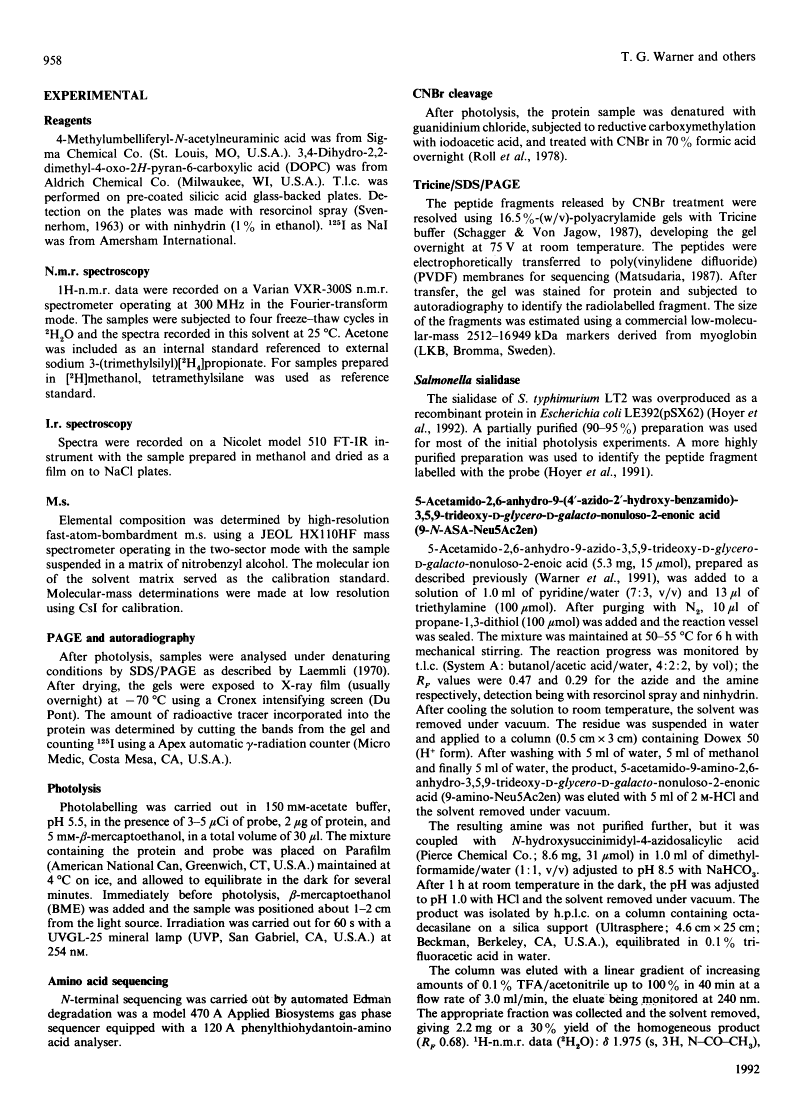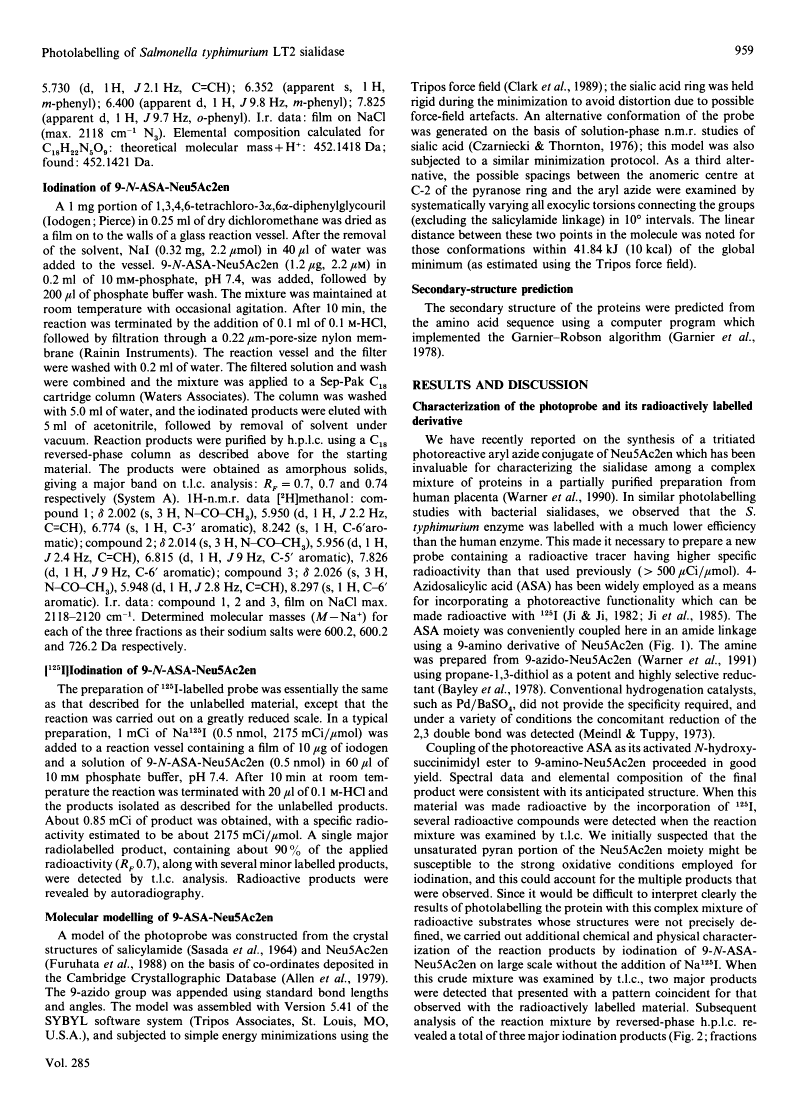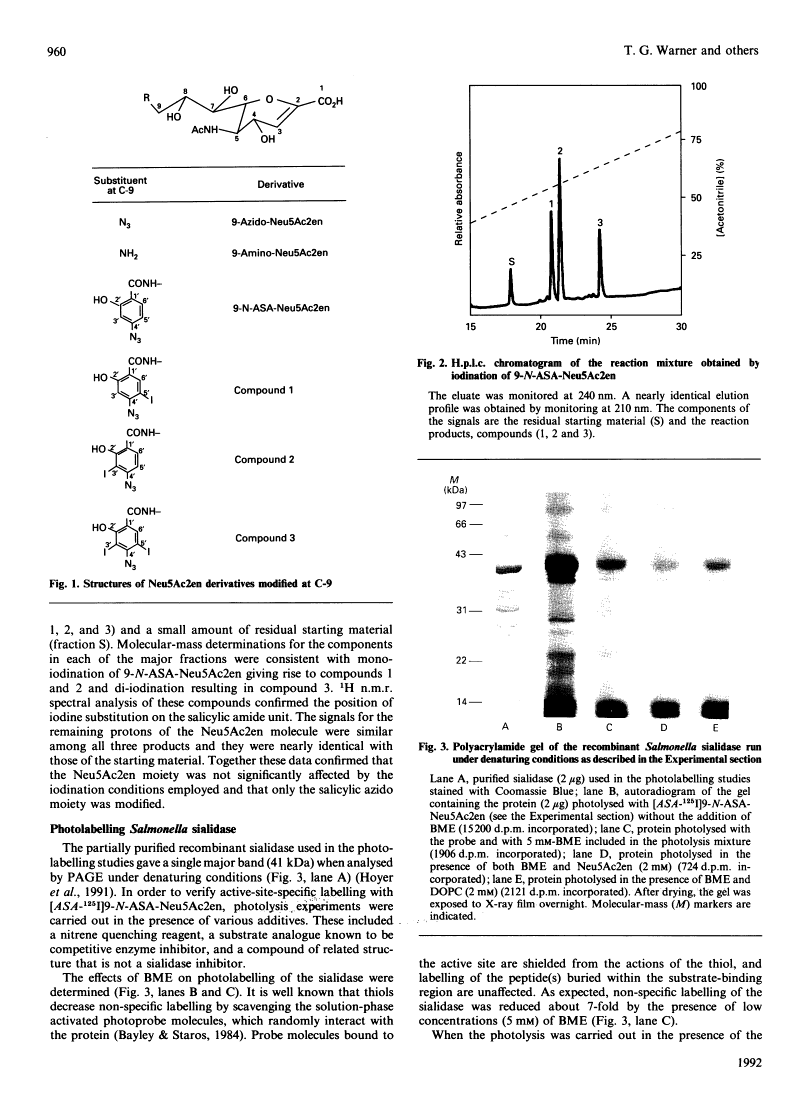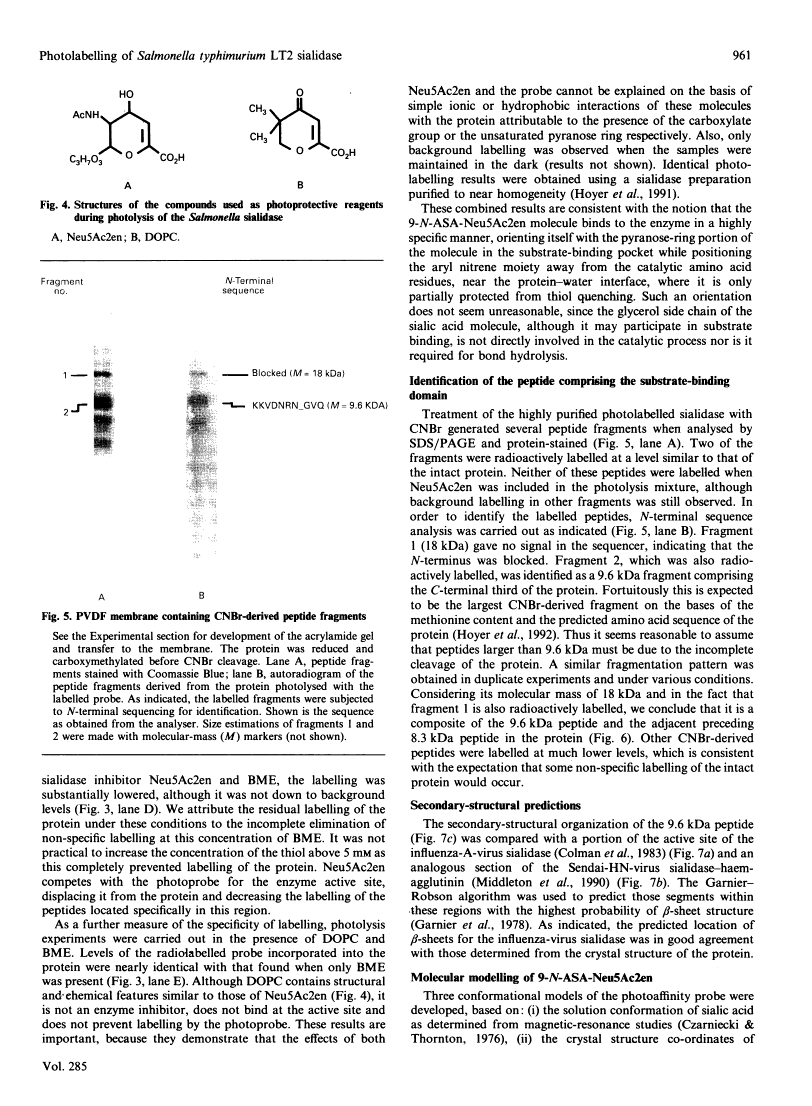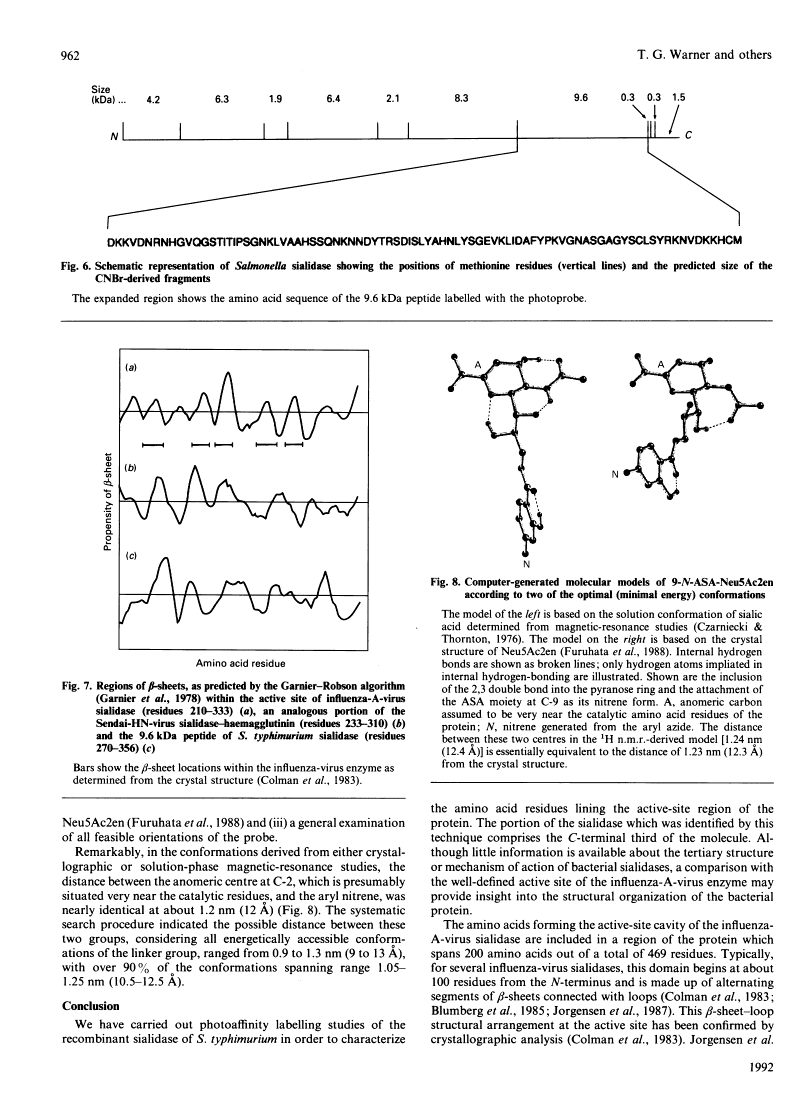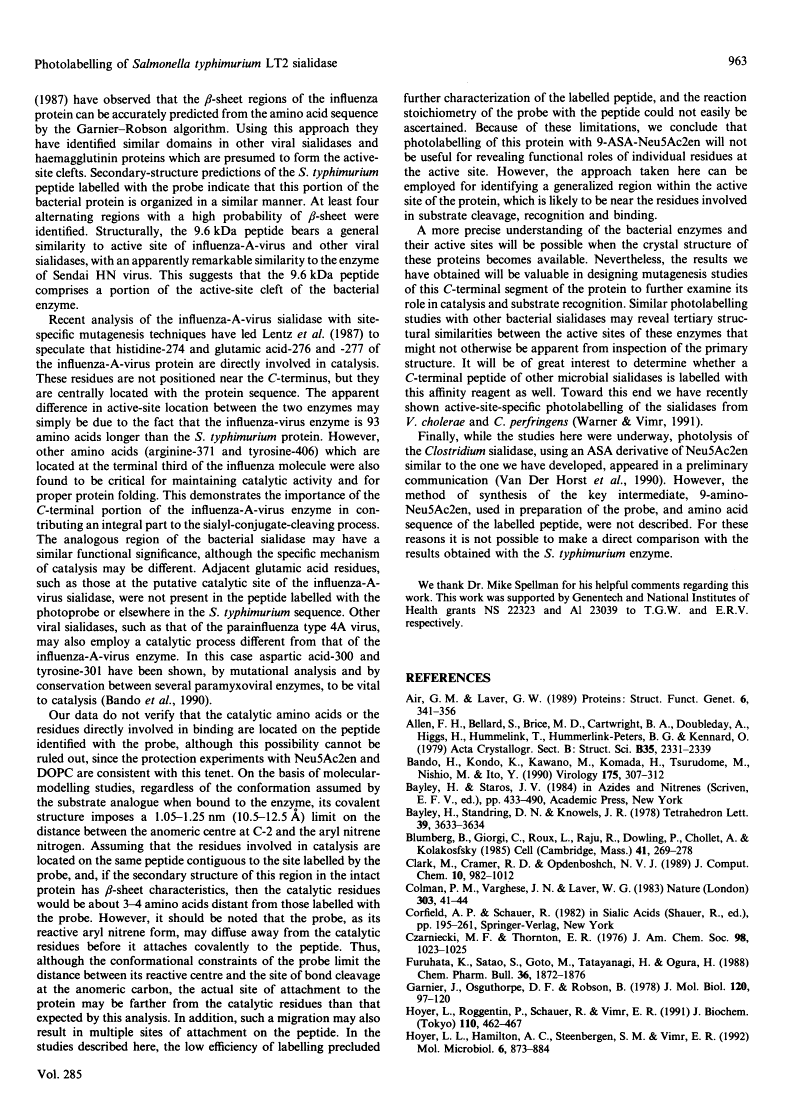Abstract
Free full text

Photolabelling of Salmonella typhimurium LT2 sialidase. Identification of a peptide with a predicted structural similarity to the active sites of influenza-virus sialidases.
Abstract
The sialidase from Salmonella typhimurium LT2 was characterized by using photoaffinity-labelling techniques. The well-known sialidase inhibitor 5-acetamido-2,6-anhydro-3,5-dideoxy-D-glycero-D-galacto-non- 2-enonic acid (Neu5Ac2en) was modified to contain an amino group at C-9, which permitted the incorporation of 4-azidosalicylic acid in amide linkage at this position. Labelling of the purified protein with the radioactive (125I) photoprobe was determined to be highly specific for a region within the active-site cavity. This conclusion was based on the observation that the competitive inhibitor Neu5Ac2en in the photolysis mixture prevented labelling of the protein. In contrast, compounds with structural and chemical features similar to the probe and Neu5Ac2en, but which were not competitive enzyme inhibitors, did not affect the photolabelling of the protein. The peptide interacting with the probe was identified by CNBr treatment of the labelled protein, followed by N-terminal sequence analysis. Inspection of the primary structure of the protein, predicted from the cloned structural gene for the sialidase [Hoyer, Hamilton, Steenbergen & Vimr (1992) Mol. Microbiol. 6, 873-884] revealed that the label was incorporated into a 9.6 kDa fragment situated within the terminal third of the molecule near the C-terminal end. Secondary-structural predictions using the Garnier-Robson algorithm [Garnier, Osguthorpe & Robson (1978) J. Mol. Biol. 120, 97-120] of the labelled peptide revealed a structural similarity to the active site of influenza-A- and Sendai-HN-virus sialidases with a repetitive series of alternating beta-sheets connected with loops.
Full text
Full text is available as a scanned copy of the original print version. Get a printable copy (PDF file) of the complete article (1.6M), or click on a page image below to browse page by page. Links to PubMed are also available for Selected References.
Images in this article
Selected References
These references are in PubMed. This may not be the complete list of references from this article.
- Air GM, Laver WG. The neuraminidase of influenza virus. Proteins. 1989;6(4):341–356. [Abstract] [Google Scholar]
- Bando H, Kondo K, Kawano M, Komada H, Tsurudome M, Nishio M, Ito Y. Molecular cloning and sequence analysis of human parainfluenza type 4A virus HN gene: its irregularities on structure and activities. Virology. 1990 Mar;175(1):307–312. [Abstract] [Google Scholar]
- Blumberg B, Giorgi C, Roux L, Raju R, Dowling P, Chollet A, Kolakofsky D. Sequence determination of the Sendai virus HN gene and its comparison to the influenza virus glycoproteins. Cell. 1985 May;41(1):269–278. [Abstract] [Google Scholar]
- Colman PM, Varghese JN, Laver WG. Structure of the catalytic and antigenic sites in influenza virus neuraminidase. Nature. 1983 May 5;303(5912):41–44. [Abstract] [Google Scholar]
- Czarniecki MF, Thornton ER. 13C spin lattice relaxation in the neuraminic acids. Evidence for an unusual intramolecular hydrogen bonding network. J Am Chem Soc. 1976 Feb 18;98(4):1023–1025. [Abstract] [Google Scholar]
- Garnier J, Osguthorpe DJ, Robson B. Analysis of the accuracy and implications of simple methods for predicting the secondary structure of globular proteins. J Mol Biol. 1978 Mar 25;120(1):97–120. [Abstract] [Google Scholar]
- Hoyer LL, Roggentin P, Schauer R, Vimr ER. Purification and properties of cloned Salmonella typhimurium LT2 sialidase with virus-typical kinetic preference for sialyl alpha 2----3 linkages. J Biochem. 1991 Sep;110(3):462–467. [Abstract] [Google Scholar]
- Hoyer LL, Hamilton AC, Steenbergen SM, Vimr ER. Cloning, sequencing and distribution of the Salmonella typhimurium LT2 sialidase gene, nanH, provides evidence for interspecies gene transfer. Mol Microbiol. 1992 Apr;6(7):873–884. [Abstract] [Google Scholar]
- Ji TH, Ji I. Macromolecular photoaffinity labeling with radioactive photoactivable heterobifunctional reagents. Anal Biochem. 1982 Apr;121(2):286–289. [Abstract] [Google Scholar]
- Ji I, Shin J, Ji TH. Radioiodination of a photoactivatable heterobifunctional reagent. Anal Biochem. 1985 Dec;151(2):348–349. [Abstract] [Google Scholar]
- Jorgensen ED, Collins PL, Lomedico PT. Cloning and nucleotide sequence of Newcastle disease virus hemagglutinin-neuraminidase mRNA: identification of a putative sialic acid binding site. Virology. 1987 Jan;156(1):12–24. [Abstract] [Google Scholar]
- Laemmli UK. Cleavage of structural proteins during the assembly of the head of bacteriophage T4. Nature. 1970 Aug 15;227(5259):680–685. [Abstract] [Google Scholar]
- Lentz MR, Webster RG, Air GM. Site-directed mutation of the active site of influenza neuraminidase and implications for the catalytic mechanism. Biochemistry. 1987 Aug 25;26(17):5351–5358. [Abstract] [Google Scholar]
- Lowden JA, O'Brien JS. Sialidosis: a review of human neuraminidase deficiency. Am J Hum Genet. 1979 Jan;31(1):1–18. [Europe PMC free article] [Abstract] [Google Scholar]
- Matsudaira P. Sequence from picomole quantities of proteins electroblotted onto polyvinylidene difluoride membranes. J Biol Chem. 1987 Jul 25;262(21):10035–10038. [Abstract] [Google Scholar]
- Middleton Y, Tashiro M, Thai T, Oh J, Seymour J, Pritzer E, Klenk HD, Rott R, Seto JT. Nucleotide sequence analyses of the genes encoding the HN, M, NP, P, and L proteins of two host range mutants of Sendai virus. Virology. 1990 Jun;176(2):656–657. [Abstract] [Google Scholar]
- Roggentin P, Rothe B, Kaper JB, Galen J, Lawrisuk L, Vimr ER, Schauer R. Conserved sequences in bacterial and viral sialidases. Glycoconj J. 1989;6(3):349–353. [Abstract] [Google Scholar]
- Roll DE, Aguanno JJ, Coffee CJ, Glew RH. Isolation and characterization of the cyanogen bromide glycopeptide fragments of alpha-1-antitrypsin. J Biol Chem. 1978 Oct 10;253(19):6992–6996. [Abstract] [Google Scholar]
- Russo TA, Thompson JS, Godoy VG, Malamy MH. Cloning and expression of the Bacteroides fragilis TAL2480 neuraminidase gene, nanH, in Escherichia coli. J Bacteriol. 1990 May;172(5):2594–2600. [Europe PMC free article] [Abstract] [Google Scholar]
- Schägger H, von Jagow G. Tricine-sodium dodecyl sulfate-polyacrylamide gel electrophoresis for the separation of proteins in the range from 1 to 100 kDa. Anal Biochem. 1987 Nov 1;166(2):368–379. [Abstract] [Google Scholar]
- SVENNERHOLM L. CHROMATOGRAPHIC SEPARATION OF HUMAN BRAIN GANGLIOSIDES. J Neurochem. 1963 Sep;10:613–623. [Abstract] [Google Scholar]
- van der Horst GT, Mancini GM, Brossmer R, Rose U, Verheijen FW. Photoaffinity labeling of a bacterial sialidase with an aryl azide derivative of sialic acid. J Biol Chem. 1990 Jul 5;265(19):10801–10804. [Abstract] [Google Scholar]
- Warner TG. A photoreactive competitive inhibitor of the human lysosomal neuraminidase in cultured skin fibroblasts. Biochem Biophys Res Commun. 1987 Nov 13;148(3):1323–1329. [Abstract] [Google Scholar]
- Warner TG, Louie A, Potier M. Photolabeling of the alpha-neuraminidase/beta-galactosidase complex from human placenta with a photoreactive neuraminidase inhibitor. Biochem Biophys Res Commun. 1990 Nov 30;173(1):13–19. [Abstract] [Google Scholar]
- Warner TG, Louie A, Potier M, Ribeiro A. Distinguishing mammalian sialidases by inhibition kinetics with novel derivatives of 5-acetamido-2,6-anhydro-3,5-dideoxy-D-glycero-D-galacto-non-2-enonic acid, an unsaturated derivative of N-acetylneuraminic acid. Carbohydr Res. 1991 Aug 20;215(2):315–321. [Abstract] [Google Scholar]
Associated Data
Articles from Biochemical Journal are provided here courtesy of The Biochemical Society
Full text links
Read article at publisher's site: https://doi.org/10.1042/bj2850957
Read article for free, from open access legal sources, via Unpaywall:
https://europepmc.org/articles/pmc1132888?pdf=render
Citations & impact
Impact metrics
Citations of article over time
Alternative metrics
Article citations
Photoaffinity labeling of sialidase with a biotin-conjugated phenylaminodiazirine derivative of 2,3-didehydro-2-deoxy-N-acetylneuraminic acid.
Biol Pharm Bull, 31(3):352-356, 01 Mar 2008
Cited by: 3 articles | PMID: 18310891
Genetic map of Salmonella typhimurium, edition VIII.
Microbiol Rev, 59(2):241-303, 01 Jun 1995
Cited by: 75 articles | PMID: 7603411 | PMCID: PMC239362
Review Free full text in Europe PMC
A neuraminidase from Streptococcus pneumoniae has the features of a surface protein.
Infect Immun, 62(9):3688-3695, 01 Sep 1994
Cited by: 88 articles | PMID: 8063384 | PMCID: PMC303019
Drosophila kelch motif is derived from a common enzyme fold.
J Mol Biol, 236(5):1277-1282, 01 Mar 1994
Cited by: 124 articles | PMID: 8126718
Crystal structure of a bacterial sialidase (from Salmonella typhimurium LT2) shows the same fold as an influenza virus neuraminidase.
Proc Natl Acad Sci U S A, 90(21):9852-9856, 01 Nov 1993
Cited by: 137 articles | PMID: 8234325 | PMCID: PMC47670
Go to all (8) article citations
Data
Data behind the article
This data has been text mined from the article, or deposited into data resources.
BioStudies: supplemental material and supporting data
Similar Articles
To arrive at the top five similar articles we use a word-weighted algorithm to compare words from the Title and Abstract of each citation.
Novel 3,4-disubstituted-Neu5Ac2en derivatives as probes to investigate flexibility of the influenza virus sialidase 150-loop.
Bioorg Med Chem, 21(16):4820-4830, 06 Jun 2013
Cited by: 2 articles | PMID: 23800724
Crystal structure of a bacterial sialidase (from Salmonella typhimurium LT2) shows the same fold as an influenza virus neuraminidase.
Proc Natl Acad Sci U S A, 90(21):9852-9856, 01 Nov 1993
Cited by: 137 articles | PMID: 8234325 | PMCID: PMC47670
Photoaffinity labeling of a bacterial sialidase with an aryl azide derivative of sialic acid.
J Biol Chem, 265(19):10801-10804, 01 Jul 1990
Cited by: 11 articles | PMID: 2358439
Sialidases: structures, biological significance and therapeutic potential.
Curr Opin Struct Biol, 6(6):830-837, 01 Dec 1996
Cited by: 124 articles | PMID: 8994884
Review
Funding
Funders who supported this work.
NINDS NIH HHS (1)
Grant ID: NS 22323
PHS HHS (1)
Grant ID: A1 23039

